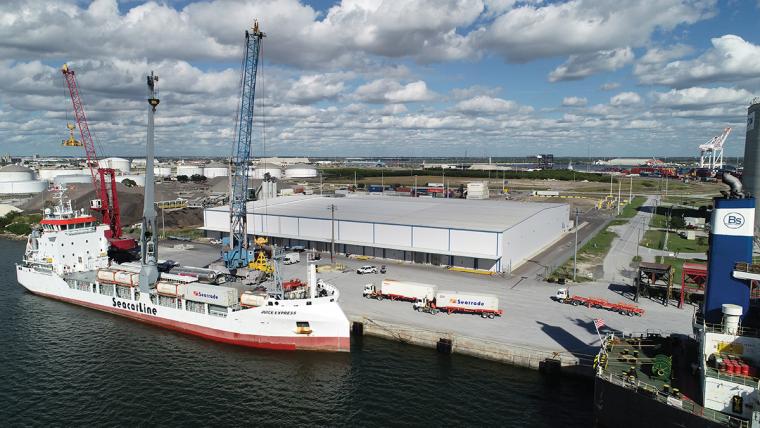

Gulfport, Mississippi
The Port of Gulfport is a deepwater, international seaport strategically located on the Gulf of Mexico. The Port of Gulfport offers significant reach, with a distribution and receiving network that extends as far north as Chicago, Illinois, east to Charleston, South Carolina and west to El Paso, Texas. With direct access to State Highway 49, and only 10 minutes from Interstate 10, trucks can easily distribute products to 75 percent of the country within 24 hours. The Port’s central location also benefits the military by serving as one of 17 Strategic Seaports in the U.S. and adds to the uniqueness of South Mississippi’s strategic defense corridor.
In addition, the Port of Gulfport is a key gateway for Central America and is the second largest importer of green fruit in the U.S., serving as the primary U.S. Gulf import and distribution center for both Dole and Chiquita. The port currently has nine tenants including Dole, Crowley, Chemours, Chiquita, The University of Southern Mississippi, Island View Casino Resort, TopShip, Harvey Gulf and the Maritime Administration of the United States of America (MARAD).
With the Port of Gulfport Restoration Program (PGRP) following Katrina now complete, the Port is evaluating future expansion options at the deepwater terminal that will allow for greater cargo throughput. The Port is currently pursuing the option to complete a 282-acre dredge and fill program for further expansion of the west pier, north harbor, and east pier. The Port is also pursuing the necessary approvals to deepen the channel up to 47 feet to allow for larger vessels to enter Gulfport.
“The Port of Gulfport is essentially an economic development agency with transportation at the core of what we do on a daily basis,” said Kimberly Aguillard, media and marketing manager for the Mississippi State Port Authority. “Cargo container operations may be what we are most associated with, but as we continue to enhance our existing sources of revenue and identify new opportunities for business development, the Port is essentially a microcosm of South Mississippi’s economy featuring tourism, education, manufacturing and cargo operations.”
Oswego County, New York
The Port of Oswego is a deepwater port on the southeastern shore of Lake Ontario. It primarily serves local and regional clients within 150 miles of the port, but it also has global import/export capabilities. The port is considered a multimodal hub and features the second-largest rail yard in Oswego County. The Port of Oswego handles various agricultural grains, potash, cement, aluminum and large items such as windmill components.
Recent investments have improved the port’s shipping capabilities with materials imported and exported via truck, ship and rail. In recent years, the port has added two rail lines with 65-car capacity onsite to meet industrial needs. The port also acquired a 365-ton portable crane, one of the largest on the Great Lakes, suitable for large lift projects.
The Port of Oswego is undergoing phase one of the Agricultural Export Center project including a new 14,000-metric-ton dome for storing agricultural products and a 14,500-bushel grain silo with multimodal transport capabilities in and out. It’s also developing a new 25-slip deepwater marina and investigating solar and other green technologies to become a zero-emissions port. Additionally, The Port of Oswego will be investing $6.2 million in dock upgrades and $2.1 million in a warehouse expansion project.
“The Port of Oswego is the port on the move in the Great Lakes,” said William Scriber, Executive Director of the Port of Oswego Authority. “Over the next six years, we will invest over $35 million into port facilities that will make us one of the most modern and technologically advanced ports on the Great Lakes and will lead to economic opportunities for our regional businesses and agricultural producers.”
Port Freeport, Texas
Port Freeport is a deepwater port that rests on the Texas Gulf Coast three miles from the open waters of the Gulf of Mexico. Port Freeport offers an abundance of acreage for development with more than 500 acres environmentally mitigated and shovel-ready. Port Freeport was established in 1925 when the voters of Brazoria County recognized the importance of having a reliable waterway to move commerce. Today, it transports automobiles, equipment and machinery, agricultural products, green fruit, containerized cargo, steel pipe, project cargo, bulk aggregate, liquefied natural gas, crude oil, natural gas liquids, petrochemicals, liquid carbon dioxide and other goods.
During the past five years, Port Freeport has experienced exponential growth and is taking strategic initiatives to maintain that growth and provide the surrounding community with jobs and economic benefits.
Within Texas alone, Port Freeport was responsible for 150,561 jobs and $9 billion in income while generating economic output of $98.8 billion in 2017, according to a 2019 study by the Texas A&M Transportation Institute. The statewide impact figure is more than double that calculated in a similar analysis just five years earlier. The most recent report puts Port Freeport’s nationwide impact at $149 billion, with the port supporting 279,783 U.S. jobs.
To meet future demand, the port continues to expand. A Velasco Terminal Expansion was completed in May 2020, and a contract was awarded for a 927-foot berth extension in December 2019. An additional STS Post-Panamax Gantry crane installation will be completed in 2022. Also, a Freeport Harbor Channel Improvement Project will begin this fall to deepen the channel from the current depth of 46 feet MLLW to a projected depth of 51 to 56 feet MLLW, making Port Freeport the deepest in Texas. Port Freeport also completed a Multi-Modal Industrial Park-Phase 1 Rail project in June 2019. This expansion includes a 6,000-foot lead track and 15,000 feet of ladder track. Finally, 20 acres of OEM storage were brought into service in August 2020.
“Port Freeport is among the top 10 fastest-growing U.S. ports for exports according to Forbes magazine,” said Jason Miura, Director of Business and Economic Development for the port. “Currently, Port Freeport is sixth in chemicals, 17th in foreign waterborne tonnage and 26th in containers.”
Port Tampa Bay, Florida
Port Tampa Bay, Florida’s largest port handling over 35 million tons of cargo per year, is one of the most diversified ports in the country. Port Tampa Bay is the closest port to Florida’s Distribution Hub – the Tampa/Orlando I-4 Corridor – which has the largest concentration of distribution centers in the state and is one of the hottest industrial real estate markets in the country.
The addition of new direct Asia container services last year was a major leap forward in serving Florida’s largest and fastest-growing market, with eight of the top global container lines now offering weekly service from Port Tampa Bay. Importers and exporters see significant savings in their supply chain distribution costs as truckers can now make multiple round-trip deliveries per day from Port Tampa Bay to these distribution centers, which service the entire state and reach into markets throughout the Southeast and beyond.
To keep pace with this rapid growth, Port Tampa Bay is expanding terminal capacity with additional paved storage, extended berths, cranes and equipment, and a new on-dock refrigerated warehouse.
Home to almost half of Florida’s population of 21 million residents as well as being a major tourism destination, the expanding I-4 corridor market is fueling demand for everything from retail, e-commerce and food and beverage, to energy products and construction and building materials.
“These are exciting times and Port Tampa Bay is honored to play an important role in providing a better supply chain solution to help facilitate Florida’s overseas trade,” said Paul Anderson, Port Tampa Bay’s President and CEO.
Visalia, California
Distributors and manufacturers have discovered the 4,000-acre Visalia Industrial Park (VIP) in Central California and its ability to reach 95 million consumers. The most recent project is the 425,000-square-foot UPS hub. Amazon is in the early stages of developing a 1.3 million-square-foot distribution center. Another 697,000-square-foot development is in the works, and two 300,000-square-foot spec buildings are nearing completion.
Additional expansions are expected as national and international firms discover overnight shipping to the western U.S. from Visalia, the affordability of homes, a walkable downtown and a hard-working employee base. The VIP is also seeing strong internal growth, with existing businesses such as SORMA USA, California Dairies and Hydrite Chemical Co. expanding.
Activity ranges from the manufacturing and distribution of massive steel screw conveyors to the design and manufacturing of miniscule high-voltage diodes, and distribution centers that ship a wide variety of goods across the nation. Food processors looking to expand or relocate find in Visalia a community that is poised for growth and eager to meet the needs of business. Visalia has invested $152 million to expand the city’s wastewater treatment plant – setting the stage for the next significant water user.
“The City of Visalia has, for many years, focused on enhancing the VIP for the benefit of employers,” said Justin Workman, Chairman of Visalia Economic Development Corporation (VEDC). “Today, the VIP offers rail access, five-minute access to State Route 99 (the backbone of the Central Valley and beyond), roadways that have been expanded, and enhanced utilities help to meet the needs of this growing industrial park.” T&ID

